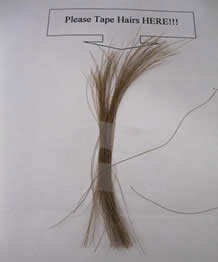Brooks Equine Genetics Research Lab
Lab Basics
DNA and Hair Sampling
How do you get DNA from a horse?
The easiest way to get DNA from a horse is to pull hair from the mane or tail with the bulb intact. Though it sounds painful, most horses have little or no reaction to having a hair sample pulled. It is also possible to get DNA from blood. Blood yields more DNA with higher purity than hair, but it’s much easier for owners to pull a hair sample.
What does the Brooks Lab do with the sample?
Once a hair or blood sample is received at the Brooks Lab, it is assigned a random accession number which will be used to identify the horse/sample in all future talks and presentations.
Hair samples are kept in binders in manila envelopes until it is time to extract DNA. Any hair submitted in plastic bags must be removed and transferred to an envelope because moisture trapped in plastic bags can damage the DNA on the hair bulb. Hair bulb DNA can be stable for years if kept in a cool, dry place.
There are two methods to extract DNA from hair bulbs, but both protocols begin by cutting the bulb off the hair. Different methods of hair bulb DNA extraction are specific for how the DNA will be used later on.
The DNA is now ready to be used for whatever the lab needs.
Hair Samples
The primary source of DNA for our lab is pulled hair samples with the hair bulb intact. Below are instructions on how to collect and submit hair samples for our various studies.
Hair can be pulled from either the mane or tail. We find it easier to take hair from the tail; the hair is longer to hang onto and the hair can be pulled in a downward motion rather than upward that is sometimes required for mane hair (i.e. you have a very tall horse). Below is an example of hair bulbs.

Most studies require at least 30 strands, or a pencil’s width, of hair. The hairs can either be pulled in one clump, or in several clumps from different areas of the tail along the tail bone.
Tips on pulling hair:
- Wrap the hairs around your hand, then jerk down in one quick motion.
- To protect your hand, wrap masking tape around your pinkie finger.
- Keeping the bulb ends together, trim off the excess hair leaving at least 4 inches from the bulb.
Tape the hairs to the paper with the bulb end towards the top of the paper and with the tape in the middle of the hair sample. Hairs do not need taped individually. Below is an example of how the hairs should be taped.
